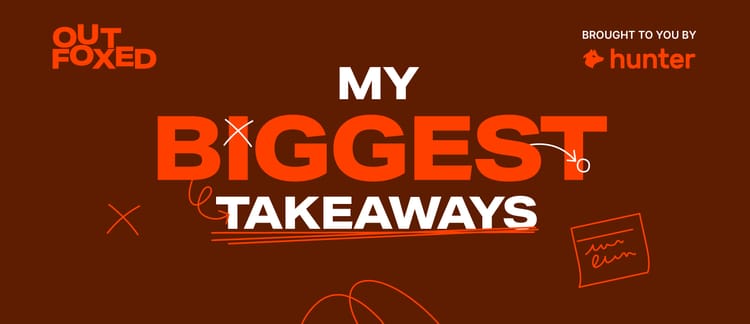Rand Fishkin on Growth Without the Hype: 5 Real Lessons for Founders and Marketers

Rand Fishkin has spent two decades helping founders and marketers navigate one of business’s hardest challenges: staying grounded when everything changes. From building Moz to SparkToro, Rand’s approach to growth has always been about truth over theory.
In this episode of Outfoxed, he shared lessons every small business founder or marketer can apply — lessons on channel strategy, measurement, resilience, and authenticity.
Here’s what we learned and how to outfox your competitors with it.
Please note: These thoughts are a reflection of the author and do not represent those of Rand Fishkin, SparkToro, Hunter.io, Matt Tharp, or any employees or partners of the aforementioned.
TL;DR summary of Outfoxed, episode 3.
In Episode 3 of Outfoxed, Rand Fishkin shares how small business founders and marketers can grow smarter — not louder.
- Don’t build on borrowed land: diversify channels so one platform can’t derail your growth.
- Measure lift, not clicks: real marketing impact can’t always be tracked — focus on resonance, not vanity metrics.
- Go where your customers (and passions) go: pick channels you love and where your audience naturally lives.
- Build around your strengths: design your business to amplify what you’re great at — and remove what you’re not.
- Stay human in the age of AI: use tech to enhance creativity, not replace connection.
Each lesson is a reminder that growth is about truth over theory — and those who stay adaptable, authentic, and audience-driven will always outfox their competitors.
1. Don’t Build on Borrowed Land
The Challenge:
It’s tempting to put all your energy into one platform — until it changes overnight. Rand spoke about SparkToro’s pivot after Twitter cut off its data access, forcing a rethink of how to serve users and survive.
“When an entire segment of your customer population changes the way they do what you do — or a platform they use completely changes — you have to have fallbacks.”
What That Means:
Relying on a single growth channel or platform is fragile. Every founder knows the pain of algorithm shifts or ad costs doubling overnight.
How to Outfox Your Competitors:
Own your audience. Build your list, nurture your community, and diversify where your users find you. If one channel disappears tomorrow, your growth shouldn’t.
2. Measure Lift, Not Clicks
The Challenge:
Attribution has become a trap. We’ve spent years trying to measure every click, every conversion path — and in doing so, we’ve lost sight of creativity.
“Throw out the old concept of attribution. Treat your channels like billboards in 1965 — measure lift, not clicks.”
What That Means:
The best marketing often can’t be traced. It’s about familiarity, storytelling, and emotional resonance — not spreadsheets.
How to Outfox Your Competitors:
Run campaigns that feel human. Measure success by how people talk about you, not just how they click. When competitors chase precision, win with presence.
3. Go Where Your Customers (and Passions) Go
The Challenge:
Small businesses often try to be everywhere. But spreading thin on channels you don’t enjoy kills creativity — and it shows.
“When you choose your channels and your tactics, especially if you’re small and starting up, focus on things that you’re personally passionate about. If you hate Instagram, don’t use it for marketing. You’re going to suck a bunch of time and energy out of yourself. Are you great at one-to-one emails? At conferences and events? Do more of that.”
What That Means:
Founders should market where they naturally show up best. The channels you love are where your best energy — and your audience’s attention — will meet.
How to Outfox Your Competitors:
Choose two channels you genuinely enjoy and commit. Consistency beats coverage. When your marketing feels effortless, it performs better.
4. Build Around What You’re Great At
The Challenge:
Most founders try to fix their weaknesses instead of leveraging their strengths. Rand argues for the opposite.
“Build your company to optimize for the things you’re great at — and design it so you don’t need the things you’re bad at.”
What That Means:
Play to your natural skills — whether that’s storytelling, data, design, or product — and design your systems around them. You can build a company that doesn't rely on your biggest weaknesses.
How to Outfox Your Competitors:
Audit your team’s strengths and cut what drains you. Outfoxing isn’t about doing more — it’s about doing the right things brilliantly.
5. Stay Human In The Face Of AI
The Challenge
AI can automate almost anything — except emotion. Many businesses are leaning too heavily into automation and losing their human edge.
“AI will help clever people do more clever things, but it won’t replace human creativity, empathy, or storytelling.”
What That Means:
AI should enhance what you do, not define it. Authentic voices still build trust and connection — things automation can’t fake.
How to Outfox Your Competitors:
Use AI to save time, not take the mic. Keep your voice, empathy, and ideas at the core of your marketing.
Final Takeaways
Rand’s perspective embodies what Outfoxed is all about — cutting through theory and hype to focus on what really makes businesses grow: creativity, authenticity, and adaptability.
🎧 Listen to Rand’s episode of Outfoxed wherever you find your favorite podcasts:
Want More from Outfoxed?
If you enjoyed Rand’s episode, check out the stories that started it all:
- 🎙️ Spike Johnson on creativity, storytelling, and building something meaningful
- 🎙️ Joel Simkins on the reality of growth, from cold calls to leading an investment firm
Each episode of Outfoxed gives the mic to real builders — founders, creators, and operators — sharing the truth of growth.
👉 Subscribe now so you never miss a conversation that keeps you grounded and inspired: https://outfoxed.hunter.io


 Send cold emails with Hunter
Send cold emails with Hunter